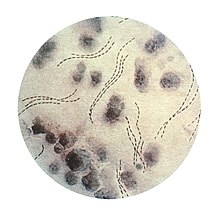Pasteurellales
| Pasteurellaceae | |
|---|---|
 |
|
| Haemophilus ducreyi | |
| Scientific classification | |
| Kingdom: | Bacteria |
| Phylum: | Proteobacteria |
| Class: | Gammaproteobacteria |
| Order: | Pasteurellales |
| Family: |
Pasteurellaceae Castellani & Chalmers, 1919 |
| Genera | |
|
Actinobacillus |
|
Actinobacillus
Aggregatibacter
Avibacterium
Basfia
Bibersteinia
Bisgaardia
Chelonobacter
Cricetibacter
Frederiksenia
Gallibacterium
Haemophilus
Histophilus
Lonepinella
Mannheimia
Mesocricetibacter
Muribacter
Necropsobacter
Nicoletella
Otariodibacter
Pasteurella
Phocoenobacter
Seminibacterium
Terrahaemophilus
Testudinibacter
Ursidibacter
Vespertiliibacter
Volucribacter
The Pasteurellaceae comprise a large family of Gram-negative bacteria. Most members live as commensals on mucosal surfaces of birds and mammals, especially in the upper respiratory tract. Pasteurellaceae are typically rod-shaped, and are a notable group of facultative anaerobes. Their biochemical characteristics can be distinguished from the related Enterobacteriaceae by the presence of oxidase, and from most other similar bacteria by the absence of flagella.
Bacteria in the family Pasteurellaceae have been classified into a number of genera based on metabolic properties, but these classifications are not generally accurate reflections of the evolutionary relationships between different species. Haemophilus influenzae was the first organism to have its genome sequenced and has been studied intensively by genetic and molecular methodologies. The Haemophilus genus is a notorious human pathogen associated with bacteremia, pneumonia, meningitis and chancroid. Other pathogenic members belonging to the Pasteurellaceae family include Aggregatibacter, Mannheimia, Pasteurella, and Actinobacillus species.
...
Wikipedia
